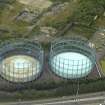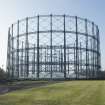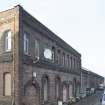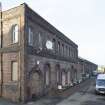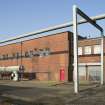Pricing Change
New pricing for orders of material from this site will come into place shortly. Charges for supply of digital images, digitisation on demand, prints and licensing will be altered.
Glasgow, Provan Road, Provan Gasworks, Gasholder No.2
Gas Holder (Modern)
Site Name Glasgow, Provan Road, Provan Gasworks, Gasholder No.2
Classification Gas Holder (Modern)
Alternative Name(s) Provan Gas Works; Provanmill
Canmore ID 277692
Site Number NS66NW 30.02
NGR NS 62115 66310
Datum OSGB36 - NGR
Permalink http://canmore.org.uk/site/277692
- Council Glasgow, City Of
- Parish Glasgow (City Of Glasgow)
- Former Region Strathclyde
- Former District City Of Glasgow
- Former County Lanarkshire
NS66NW 30.02 62115 66310
Construction (1903)
W Foules and A Wilson, Glasgow Corporation engineers.
Note (1992)
Provan Gasholder No. 2 is a water-sealed, 3 lift column, 8,777,000 cubic feet capacity holder dating from 1903. It was reconstructed in 1952-3. The tank is by The Barrowfield Ironworks Limited (tank builder unknown). By the time of decommissioning, it had been used to store natural gas.
The diameter of the different lifts of the holder are as follows: 273' 9" (top), 276' 10.5" (second), and 280' 0" (third) and all with a depth of 50' 0".
The holder is constructed from 30 steel, latticed columns 152' 6" in height.
There are 4 tiers of steel latticed girders with a top tier measuring 29' 6" in length by 3' 0" in depth.
The second tier is 29' 6" in length by 3' 0" in depth of latticed box construction.
The third and fourth tiers tiers are 29' 6" by 3' 6" latticed box construction.
There are 4 tiers of bracing flats. The top and second tiers have 5" by 3/8" flats. The third tier has 6" by 3/4" flats. The fourth tier has 7" by 3/4" flats.
The crown rise is 25'. It has 4 flat manhole covers and is fitted with anti-vacuum devices (mechanical operation trip; crown sealing plate; holder low pressure trip).
It has 4 X 6" Audco valves at centre - gas and air vents spaced around the holder (strong row).
The sheeting thickness is as follows: Crown, Outer Row is 3/4". Sheeting thickness at Top Row is 9/16" and at the Bottom Row is 5/8". All lifts are noted as being the same thickness.
Cups and grips are 10" pressed plate cup.
The tank is a of bent plate curb construction with timber framing in the tank.
Access to the holders is by staircases, walkways and ladders attached to the framing.
The tank measures 283' 7" in diameter, with a depth of 51' 0" with the top curb at ground level.
The gasholder is of mild steel, rivetted and welded (later) construction.
The tank is of brick and puddled clay construction. The inlet and outlets are 40" in width. The connections: inlet on north and outlet to the south and separated.
Information from [insurance] Report on Examination of Gasholder (water sealed type), British Gas Corporation - Scottish Region, Provan, Glagow, 18 September 1992.
MS/
Project (2007)
This project was undertaken to input site information listed in 'Civil engineering heritage: Scotland - Lowlands and Borders' by R Paxton and J Shipway, 2007.
Publication Account (2007)
The two most historic gasholders at Provan, Nos. 1 and 2, built side by side in 1903, are identical, and highly visible from the M8 motorway east of the city centre. They measure 283 ft 7 in. in diameter and have a capacity of upto 8.77 million cu. ft of natural gas. The holders are made of steel and are retained by vertical guides of 30 steel lattice columns 153 ft high, connected by four tiers of horizontal lattice girders, all of elegant construction.
The base of the holders is located in tanks 51 ft deep constructed in brickwork and sealed with puddle clay,
the builders of which, together with the retort houses and other operational buildings (now demolished), were
Sir Robert McAlpine as part of their £300 000 contract. No. 1 gasholder was fabricated by Mechans Ltd and No. 2 by Barrowfield Ironworks Co. Ltd. The Glasgow Corporation engineers were W. Foules and A. Wilson.
As the strata consisted of boulder clay, McAlpine’s erected a complete brick-making plant with an output of
40 000 bricks per day and all the common bricks used in construction were made on site.
R Paxton and J Shipway 2007
Reproduced from 'Civil Engineering heritage: Scotland - Lowlands and Borders' with kind permission of Thomas Telford Publishers.
Note (2016)
Gasholder No. 1 is a variation on the type 32 holder. Type 32 holders had equal chords to the front of and the back of the standards to create an 'I' shape. The conventional tapered standards appear to have taken over from lattcie T section from around 1890. This 'I' section was used with a variety of girder type. At Provan and Temple in Glasgow, the section was used with box lattice girders.
Provan and Temple are the earliest examples surviving of the Type 32 in Scotand but not in the UK
Information from SGN, (Scott Lewis), December 2016.
Standing Building Recording (20 January 2020 - 25 January 2020)
Gasholder No 1: NS 62021 66262, Gasholder No 2: NS 62116 66304, Gasholder No 3: NS 62467 66917, Offices: NS 62401 66449, Workshops: NS 62410 66494, Control Room: NS 62290 66375, Sub-station: NS 62373 66526 A historic building survey was undertaken of redundant Gasholders Nos 1–3 on Blochairn Road in Provan, Glasgow in advance of demolition. The work was done on 20–25 January 2020.
The Provan gasworks has been a functioning site since 1904 with several different phases of gas production and storage on site during its ongoing 116-year lifespan. Gasholders Nos 1–3 and several brick structures are no longer in use, although the site is still in daily operation using high pressure gas apparatus. The site was once the largest gasworks in Scotland but today over half the site is empty with the work areas concentrated in the south. The gasworks were highly regarded for gas production due to the constantly evolving apparatus and techniques used to manufacture high quality gas economically. The site was originally built to fulfil the growing demands for gas in homes and businesses across central Scotland and continued to successfully fulfil these demands until natural gas use became more economical at the end of the 1960s.
Gasholders Nos 1 and 2 were built in 1903 during the site’s initial construction making Gasholder No. 2 one of the oldest in Scotland, behind only Granton, Edinburgh. Gasholder No. 1 was later rebuilt identically in the early 1950s. Their variation of the Type 32 design guide frame was common around the time of original construction.
Gasholder No. 3 was built in 1970, a late date for any gasholder construction although the spiral-guided style was the most common design in the later gasholders.
Archive: NRHE (intended)
Funder: SGN
Diana Sproat and Gemma Hudson − AOC Archaeology Group
(Source: DES Vol 21)




















































